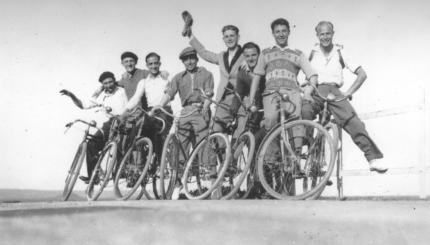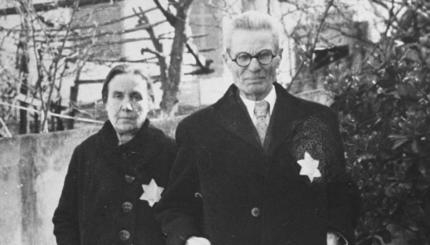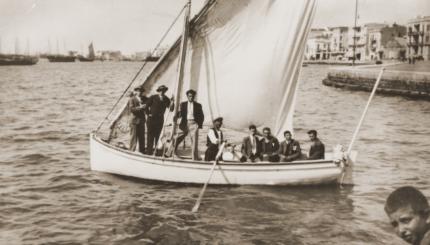Like Yiddish, Ladino is viewed as a personal language of the Jewish people. It’s sometimes called “el espanol muestro“–“our Spanish”–and everything about it is tied to the ideas of home and identity. When Jews were expelled from Spain in 1492, they carried “their” Spanish with them, and so the Judeo-Spanish language moved throughout the Ottoman Empire, binding Jews to their heritage and their original home in Spain.
In time, Judeo-Spanish sponged up some of the vocabulary of the new home countries of Spanish Jews, with Turkish, Greek, and Hebrew making their way into the language. That’s why today, there are many different dialects within Ladino, with each area of the world putting its own stamp on the language.
As the language changed addresses, what it was called changed, too. In Turkey and the Balkans, Judeo-Spanish was called “Ladino,” derived from the word Latin, so no one would confuse it with Turkish. In Morocco it was called “Haquitiya,” and sometimes spoken Ladino is called “Djudesmo.”
Ladino’s History
Ladino has always been the language of the multilingual. “Ladino,” or latinus in Latin, refers to a person who could speak a few languages in addition to his mother tongue, which was the case for most Ladino speakers. Ladino has its roots in the Latin spoken by the Romans who occupied the Iberian Peninsula from 200 B.C.E. to 425 B.C.E., but today’s Ladino is closer to modern Spanish plus a mix of whatever other languages Ladino speakers knew.

Help us keep Jewish knowledge accessible to millions of people around the world.
Your donation to My Jewish Learning fuels endless journeys of Jewish discovery. With your help, My Jewish Learning can continue to provide nonstop opportunities for learning, connection and growth.
Just as Yiddish became the cultural underpinning of the entire European-Jewish, or world, with its own folklore, music, and literature, so Ladino has a rich tradition of literature, theater, folk tales and music. Ladino stories even have their own recurring character, Jocha, or Ejoha, who is alternately a fool, a wise fool, and a wily trickster, just as the Yiddish stories have the recurring foolish men of Chelm and the hapless Herschel.
The Ladino World
How many people speak Ladino? That’s a controversial issue, because the definition of “Ladino speaker” varies depending on whom you ask. Most estimates say that between 160,000 and 300,000 Sephardim (Jews of Middle Eastern or Spanish origin) worldwide have some knowledge of Ladino. In Israel, many estimate that 50,000 to 80,000 people are somewhat familiar with Ladino. A few scholars are working on surveys of Ladino speakers and other efforts to get a solid number. If a recent flurry of conferences, study centers, book-collection efforts and teacher-training programs are any indication, Ladino may be in for a revival.
“I definitely think interest in Ladino is growing,” says Trudy Balch, a translator of Ladino, who has worked on many Ladino folk tales. For the past seven years, Balch has been part of a theater group in New York called “The Ladino Players,” which puts on plays in Ladino. “One year we did three one-acts, one a translation of a one-act play by Sholom Aleichem,” she says. She’s seen both Sephardic Jews and non-Jews attend performances, and she’s observed some interest in Ladino from non-Jewish Latinos who happen to live in New York.
Where to Learn Ladino
For those who are intrigued by Ladino, classes are available at a few universities, and some Sephardi synagogues offer adult-education Ladino. The Spanish-Portuguese synagogue in New York has been offering Ladino classes for years, and The Center for Jewish History in New York offers Ladino as well.
Many local Sephardic federations offer courses in Ladino. In Israel, Spain, and Paris, Ladino programs are readily available. The online discussion group Ladinokomunita has correspondents from all over the world, and is a great resource for more Ladino information; the catch is that you must write in Ladino.
Ladino Treasures
The rewards for the student of Ladino include the ability to read the classic Me’am Loez in the original. Me’am Loez, the 18th- and 19th-century commentary on the Bible, is the major work of Ladino writing. The Ladino reader can also enjoy the many collections of proverbs and folk tales that are wise, funny, and very Jewish. Efforts to collect these treasures are making them more widely available than ever, and English translations are also being prepared.
Apart from Me’am Loez, there was a flowering of newspaper writing, translation, and pamphlets in the late 19th and early 20th centuries. There were several Ladino newspapers in Istanbul, Turkey, and Salonika, Greece.
For centuries, Ladino was written in Hebrew characters, using either the special alphabet employed by the medieval commentator Rashi or a cursive script called solitreo. Most Ladino literature is written in the Rashi alphabet. Today, Ladino is written in Latin alphabet, but in phonetic transcription instead of the spelling system of today’s Spanish. Ladino speakers emphasize that they are not writing incorrect Spanish, but rather phonetic Ladino.
Today, a few dozen American, Israeli, and European universities offer courses in Ladino. In Istanbul, a Ladino newspaper is published, but it’s the only Ladino newspaper in the world. There is an all-Ladino journal called Aki Yerushalayim, published in Jerusalem, and a Ladino-French journal called La Lettre Sepharade is published in France. Israel Radio still broadcasts in Ladino, and Radio Exterior de Espana in Spain also has a Ladino broadcast.
Ladino’s Revival
The Israeli government and private foundations are making efforts to rescue and promote Ladino. Israel has declared both Yiddish and Ladino to be endangered languages, and it has established the National Authority for Ladino and its culture. Israeli government programs include training for dozens of high-school teachers in Ladino.
Private groups have begun to move, too. The Ma’ale Adumim Institute for Ladino, located a short drive from Jerusalem, is trying to collect and catalog all Ladino books in order to preserve Judeo-Spanish heritage. It has added 300 volumes over the past three years, and its director is actively trying to locate more Ladino books. In 2002, the United Nations got involved. UNESCO, or the United Nations Educational, Scientific, and Cultural Organization sponsored an international conference on Judeo-Spanish language and culture, held in Paris in June 2002.
Although Yiddish suffered greatly in the Holocaust, the blow to Ladino was even stronger, says Balch, the Ladino translator. The communities of Salonika and other centers of Ladino were completely destroyed, and since there have always been fewer Ladino speakers than Yiddish speakers, the surviving Ladino-speaker pool was much smaller.
Ladino scholars and activists are passionate about preserving the music and humor of Ladino language and literature, and as the Israeli government puts its muscle into language preservation, there is renewed hope that “our Spanish” will indeed remain ours.


